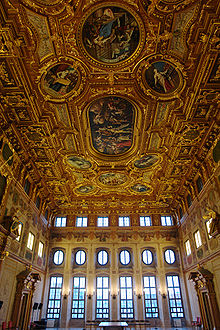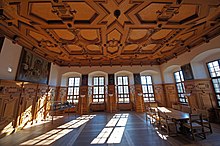Town Hall (Augsburg)
| Augsburg City Hall | |
|---|---|
 |
|
| Data | |
| place | augsburg |
| builder | Elias Holl |
| Construction year | 1615 to 1624 |
| height | 57 m |
| Coordinates | 48 ° 22 '7.3 " N , 10 ° 53' 55.3" E |
The Augsburg town hall was built from 1615 to 1624 on the east side of the town hall square in Augsburg . The 57 meter high secular building is considered one of the most important of the Renaissance architecture north of the Alps and, together with the Perlach Tower, represents the city's landmark. Until the completion of the Behrens building in Berlin-Oberschöneweide in 1917, it was the tallest building in Germany .
Due to its historical importance, it is subject to the Hague Convention for the Protection of Cultural Property in the Event of Armed Conflict .
History of the Augsburg town hall

In 1260, documents first mention a town hall in Augsburg, which was built in wood. After a fire 30 years later and the subsequent reconstruction, a decision was made to build a stone building in 1385. The town hall was expanded several times in 1449 and 1515/16. The facade design took place then u. a. by Jörg Brau the Elder .
Initially, the old Augsburg town hall was only to be rebuilt at the beginning of the 17th century in order to meet the requirements for holding the Reichstag , which took place in the imperial city at that time. In 1609, the city government therefore commissioned the well-known master builder Elias Holl to design a reconstruction plan for the Gothic building, which the architect struggled with. It was only after a six-year planning phase that Holl was able to present the magistrate with an appropriate renovation plan, which the city councils ultimately rejected. Surprisingly, Elias Holl received a completely different commission instead in 1614: he was supposed to demolish the old Gothic town hall, which had three gables and a bell tower, and build a magnificent new building in its place.
Elias Holl worked out a new building project with the participation of the city council and probably also the city painter Johann Matthias Kager , the development of which is documented in several architectural models. The foundation stone was laid on August 25, 1615. According to the will of the city fathers, the town hall should not have towers, but Elias Holl insisted on the well-known onion domes next to the gable and was only able to establish himself with them in 1618 - well after construction had started. In 1620 the exterior work and in 1624 the interior work was completed after a total of fifteen years of planning and nine years of construction. The town hall is considered to be Holl's masterpiece. Technically, the Augsburg Town Hall is a pioneering achievement: when it was completed, it was the only existing building in the world with more than six floors. The self-image of the imperial city of Augsburg is expressed in two unmistakable ornaments on the huge gable on the front of the town hall: the painted imperial eagle symbolized the imperial immediacy of the city, the large copper pine nut above it, the awareness of the ancient founding of the city.
Inside the town hall there are three halls lying one above the other: on the ground floor, behind the main portal, the so-called “Untere Fletz”, on the floor above the “Obere Fletz” (“Fletz” means “ hallway ”). By far the most impressive room in the building is the “ Golden Hall ” , which extends over two floors, with its magnificent portals, wall paintings and the magnificent coffered ceiling . Adjacent are the prince's rooms, which were designed as meeting places for the Reichstag and retreats for distinguished guests. The construction costs for the new Augsburg town hall were around 100,000 guilders .
The Thirty Years War , which began a few years before the town hall was completed, also badly affected Augsburg. Before the war, one of the most important economic centers on the continent, the old imperial city was in decline in the middle of the 17th century. The war had not only robbed Augsburg of its centuries of economic supremacy in Europe, but also cost the city more than half of its population. The Reichstag , for which the magnificent town hall was originally built, now took place in other German cities. Only once more - in the late 17th century - was the Augsburg town hall the scene of a festival of imperial importance, when in 1690 Joseph I held a banquet in the Golden Hall on the occasion of his coronation as Roman-German king .
In the course of the Bavarian occupation of Augsburg in 1806 (a consequence of the Napoleonic Wars), the imperial eagles, originally made of bronze, the imperial city insignia par excellence, were removed from both gable sides on Bavarian orders and have been lost ever since. In 1884 the eastern front was exposed to honor the work of Elias Holl.
Only in the course of the reconstruction work on the town hall for the 2000th anniversary of the city in 1985 were the eagles painted based on the historical model.
During the British bombing raid on Augsburg in February 1944, the town hall was hit by several high-explosive and incendiary bombs and burned down completely except for the outer walls. After the war the building was - outside in a historic and inside in a simplified form - rebuilt again used as the town hall and from the 1955th The view of the facade of the Augsburg town hall was only possible to a limited extent until the two Allied air raids on Augsburg. Only the destruction and the demolition of the opposite block with the stock exchange building , which was completed by the early 1960s, enabled today's (unhistorical) unobstructed view of the building front over the Rathausplatz . In the years 1980 to 1984 the facade of the town hall was given its original color scheme (reconstructed according to historical documents) in the course of extensive renovation work. Inside the Renaissance building, the Golden Hall, which was destroyed in the war, has been faithfully restored. On January 9, 1985, Augsburg's town hall was initially reopened in its new, old splendor as part of the city's 2000 year anniversary.
Walk through the Augsburg town hall
Unterer Fletz
The visitor enters the Augsburg town hall through an inconspicuous side gate on the front of the building and first reaches the Untere Fletz through an anteroom. This monumental hall on the ground floor with its marble columns and the heavy vaulted ceiling forms the entrance to one of the two stairwells that lead to the upper floors of the town hall.
Upper Fletz
The Obere Fletz on the first floor of the town hall once housed the office of the Augsburg councilors. Since the war, the floor has been used as a meeting room for the Augsburg city parliament, and the faction offices of the parties represented in the city council are also located here. Except for special occasions, this part of the town hall is not open to visitors.
Golden Hall
Located on the second floor of the Augsburg town hall, the Golden Hall covers an area of 552 m² with a ceiling height of 14 meters. With its impressive portals , lush wall paintings and, last but not least, the magnificent coffered ceiling , it was already considered the highlight of artistic interior design at the time of its creation. The hall takes its name from the rich gold jewelry that adorns its furnishings.
Princely room
The prince's rooms are adjacent to the Golden Hall . Originally four in number, these once important guests of the Augsburg city council served as a place to stay and retreat. Compared to the splendor of the Golden Hall, the rooms were rather dignified: coffered ceilings , wood-paneled walls, parquet floors and tiled stoves created an almost cozy atmosphere. In each of the princes' rooms there were artfully crafted desks, tables, armchairs and chairs as well as several lamps on an area of approx. 150 m². After their destruction in the Second World War, the Princely Rooms have been reconstructed since the mid-1980s. One of the rooms can already be visited again.
The Augsburg town hall today
After the renovation was completed in 1985, the Augsburg town hall houses permanent exhibitions on the history of the former imperial city and its twin cities. Frequently changing exhibitions on various historical and daily political topics in the Unteren Fletz are open to every visitor. The Golden Hall is the venue for city receptions, concerts and ceremonies.
The Augsburg town hall is one of the most visited sights in Fuggerstadt. Unterer Fletz, the souvenir shop on the ground floor and the Golden Hall are open daily - except for closed events; A small fee has to be paid to visit the Golden Hall. The traditional “Ratskeller” restaurant is located in the historic vaulted cellars of the town hall.
Since May 2007 the city of Augsburg has set up the Europe Direct information center in the town hall . It is open to all citizens for information, questions and information about the European Union. Immediately behind the town hall, on August 8th, the peace table is held on Elias-Holl-Platz on the occasion of the peace festival.
literature
- Julian Jachmann: The Art of the Augsburg Council 1588–1631. Communal spaces as a medium of domination and memory , Munich, Berlin 2008. Jachmann places the town hall building in the larger context of the imperial city's self-portrayal.
- Augsburg and its town hall 1985 - the renovation of the town hall and the Perlach tower; the reconstruction of the Golden Hall and a prince's room; a documentation . Augsburg, 1985.
- Jürgen Zimmer: The Augsburg town hall and tradition. On the conception and iconology of the building , in: Münchner Jahrbuch der bildenden Kunst , 3rd part 28 (1977), pp. 191–218.
- Elias Holl and the Augsburg City Hall - an exhibition by the City of Augsburg. City Archives, June 22nd - September 1st, 1985 . Regensburg, 1985. ISBN 3-7917-0962-3 .
- Dorothea Diemer; Peter Diemer: Elias Holl and the Augsburg City Hall. Colloquium in Augsburg City Hall, July 5th and 6th, 1985 . In: Kunstchronik, 38 (1985), pp. 502-519.
- Johannes Erichsen: Reflections on the Augsburg town hall on the occasion of the exhibition Elias Holl and the Augsburg town hall . In: Kunstchronik, 38 (1985), pp. 486–502.
- Hermann Kießling: The Golden Hall and the Princely Rooms in Augsburg City Hall . Munich, 1997. ISBN 3-422-06198-3 .
- Ludwig Leybold (ed.): The town hall of Augsburg . Berlin, 3rd edition 1893-1896.
- City Hall, Augsburg (Schnell & Steiner, Small Art Guide). Regensburg, 2006. ISBN 3-7954-6199-5 .
- Renate von Walter: The Augsburg town hall - architecture and image content . Augsburg, 1972.
Web links
- Augsburg Town Hall - (City of Augsburg)
- Augsburg Town Hall - (AugsburgWiki)
- Homepage of the Europe Direct information center of the city of Augsburg
- Brochure for the Open Monument Day 2012 (PDF; 5.9 MB)
Individual evidence
- ↑ Günther Grünsteudel, Günter Hägele, Rudolf Frankenberger (ed.): Augsburger Stadtlexikon. 2nd Edition. Perlach, Augsburg 1998, ISBN 3-922769-28-4 .
- ↑ The German city. Volume 13 . Reinhard Welz Vermittler Verlag eK, 2005, ISBN 978-3-86656-539-5 , p. 343 ( books.google.com ).
- ↑ Eastern front exposed. , In the Centralblatt der Bauverwaltung , No. 35, August 30, 1884, p. 354, accessed on December 31, 2012.



